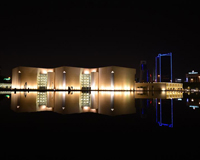Contact Center
.
20 January 2015
With 150 000 Visitors in 2014, Bahrain National Museum Stands as a Major Cultural Tourist Institution


Given the outstanding prominent role of culture in the tourism industry, Bahrain National Museum has hosted a series of art and cultural events which enhanced its role as one of the strongest tourist attractions in Bahrain in 2014.
During the last five days alone the museum received more than 2000 visitors, especially after the inauguration of ‘The Berber Women of Morocco Expo’ on Thursday 15th January 2015. The exhibition is being held under the patronage of Her Royal Highness Princess Sabeeka bint Ibrahim Al-Khalifa, Wife of His Majesty the King and President of the Supreme Council for Women (SCW). The culture directorate is organizing the expo in cooperation with Pierre Berger (Yves Saint Laurent), Jardin Majorelle’s Musée Berbère in Marrakech and Musée du Quai Branly in Paris.
The exhibition, which will run until April 15th 2015, is an invitation to travel into the heart of Morocco and Berber culture. The ‘Berber Women of Morocco’ presents some of the most beautiful objects, carpets, capes, woven belts, necklaces of amber and coral, and silver fibulae predominantly from the sumptuous collection of the Jardin Majorelle’s Musée Berbère in Marrakech and Musée du Quai Branly in Paris - Together with stunning archival photographs, it is a tribute to the women who have never ceased transmitting the Berber culture’s singular identity.
Bahrain National Museum has received more than 150,000 visitors during 2014 that came to discover the fabulous exhibitions and events presented by the museum directorate and to get acquainted with a deeply-rooted history going back 6000 years as reflected by its series of halls.
Among the distinguished exhibitions hosted by the museum, we mention the photography exhibition titled ‘Writing the Self, Writing Others’ November 2014 by Moroccan artist Lalla Essaydi. The solo exhibition traces and maps a history often coded in misunderstanding by re-visiting and re-interrogating the complexity of the Arab female identity. Inspired by 19th-century Orientalist works, Essaydi is known for paintings that combine Islamic calligraphy and representations of the female body with Western painting traditions. She frequently addresses the complexities of female identity in the Arab traditions from a personal perspective.
Also in November 2014 Bahrain National Museum hosted ‘Modern and Contemporary Saudi Art, The Al-Mansouria Collection’ which showcased modern and contemporary art from Saudi Arabia. The exhibition presented the works of 30 artists, the pioneers of the art in the 1960s and the new modern trends. Ranging from paintings and sculpture to calligraphy and video art, the featured artworks unveiled the vibrant art of Saudi Arabia.
In September 2014 H.E Shaikha Mai bint Mohammed Al Khalifa opened the ‘India Through the Lens’ photo exhibition at Bahrain National Museum. It portrays India through the contrasting oeuvres of four photographers; Jyoti Bhatt, T S Satyan, Maimouna Guerresi and Karen Knor. T.S. Satyan, who was born in Mysore in (1923-2009), and Jyoti Bhatt (born in 1934) are both Indian documentary photographers. Karen Knorr (born in 1954) and Patrizia Maïmouna Guerresi (born in 1951) are European modern artists specialized in modeling and producing photos.
In April 20104 there was the ‘Recreational Purpose’ exhibition which is a group photography exhibition commissioned on the occasion of Manama, Capital of Arab Tourism 2013. Six photographers from across the Arab World were invited to Bahrain for a short-term residency to work. The exhibition offers 11 personal and subjective readings of the urban and natural landscape and as many interpretations.
In March 2014, an exhibition showcasing Japanese centuries-old Makie art ‘Makie: Japanese Golden Inscriptions’ at Bahrain National Museum as Bahrain celebrated the 2nd ‘Year of Arts’ exhibition program. The exhibition showcased lacquer objects sprinkled with gold and silver powder to form decorative images that are distinctly Japanese. The art form spread from Imperial courts to the rest of the world as it flourished in the 16th century.
January 2014 was devoted to the Turkish art through ‘500 Years of Islamic Calligraphy- Masterpieces from Sakıp Sabancı Museum’, which presented a breathtaking showcase of the ‘Art of the Book’ from Ottoman- era Turkey. Held in collaboration with the Sakıp Sabancı Museum in Istanbul, the exhibition features intricate examples from the museum’s collection, considered to be among the finest of its kind. Displays included rare Qurans, prayer books, calligraphy, landscapes, and illuminated manuscripts by leading artists working under the patronage of Ottoman sultans from the 16th to early 20th centuries.







